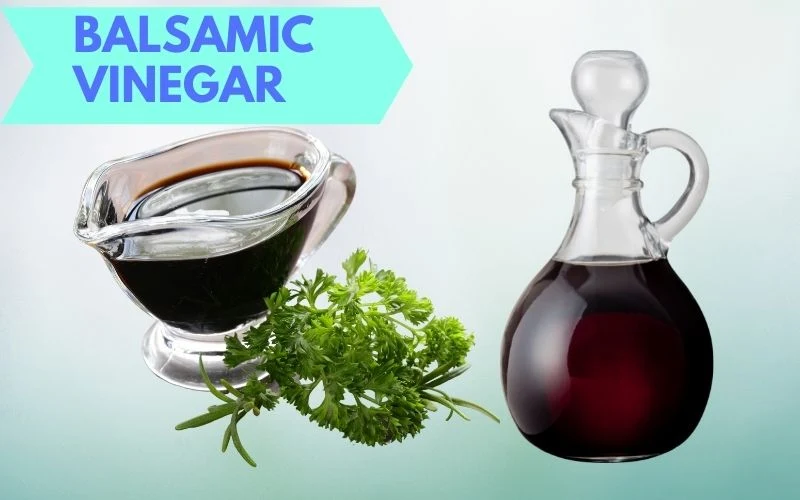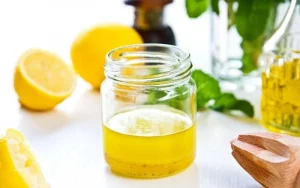
Vinaigrette is a simple and versatile salad dressing that can be used on everything from fruit to vegetables. At its most basic, it’s nothing more than an oil-vinegar emulsion with pepper, salt, and whatever aromatics or herb you enjoy. Choose a thickening method that works best for you based on how firm you want the sauce to be and what tastes you prefer.
A delicious vinaigrette salad should be tried whenever low calories and good taste are required. Lettuce, hand-picked from your garden, requires a vinaigrette salad dressing to go with it. The dressings are simple to prepare and have some of the lowest calorie counts available.
Types of Vinaigrette
1. Classic Vinaigrette
This is perfect for those who are wary of eating heavy onion-based meals once in a while. It’s tasty, filling, and keeps well for days when you’re on the move or away from home. You may make it with pantry ingredients and keep it in.
2. Thick Vinaigrette
Thick Vinaigrette is made by adding an emulsifier agent to the classic Vinaigrette. If you’d prefer a thicker vinaigrette that isn’t quite as thick as normal, use your blender to combine all of the components instead of whisking them together to form the emulsion.
3. Creamy Vinaigrette
Creamy Vinaigrette is made by adding sour cream, Mayonnaise, cream cheese, plain yogurt, and cream fraise to the classic Vinaigrette. On the other hand, a whisk breaks up fat and water into smaller droplets than a blender’s blades do, resulting in an emulsion that feels thicker on the tongue. If you like chopped shallots or garlic in your Vinaigrette, add them manually after the blitzing process to avoid being crushed by the blades.
Read More: What Is Masago Sushi And How To Make Masago Sushi?
Vinaigrette Nutrition Value
Vinaigrette’s primary goal is to increase the taste of the ingredients it is used on. Vinaigrette dressing is frequently overused, resulting in greater calorie consumption over time. The secret to making good Vinaigrette dressing is to use the correct sort and to keep your portions in check. Vinaigrettes may be seasoned with a variety of ingredients, including vinegar, herbs, shallots, onions, spices, mustard, and sugar.
Store-bought Vinaigrette varies considerably in calories and fat content. Try to limit your portion to one serving or two tablespoons of dressing. Vinaigrette is a less calorie-dense type of salad dressing than others.
The following nutrition facts are for two tablespoons (30g) of Vinaigrette salad dressing:
- Calories: 90
- Sodium: 280mg
- Sugars: 1g
- Fiber: 0g
- Fat: 9g
- Carbohydrates: 3g
- Protein: 0g
What is Balsamic Vinegar?
Balsamic vinegar is a dark, richly flavored vinegar that may be used to complement salad dressings, marinades, and sauces. Reduced balsamic glaze can be drizzled over strawberries, incorporated into risotto, or tossed with Brussels sprouts or red onions to caramelize its sugars in the oven.
How To Make Balsamic Vinegar?

Because of the aging process that it goes through, balsamic vinegar is more expensive than other vinegar. Use this step-by-step guide of making it if you are hesitant to purchase it due to the price.
Ingredients
- 1 Tbsp red wine vinegar or apple cider.
- 1/2 tsp brown sugar, honey or granulated sugar
Preparation
- Add the vinegar and sugar (or honey) to a mixing dish. Balsamic vinegar has a subtle molasses flavor. Use brown sugar instead of granulated sugar to bring that nuance into your substitute. Brown sugar, like blackstrap, gets its color and flavor from molasses.
- Use a tablespoon of your substitute instead of a Tbsp of balsamic vinegar. If your recipe asks for more, increase the amount by half or triple it. This replacement is simple to adjust to your needs.
Smoothie Recipe: Avocado Smoothie Recipes for Weight Loss
Health Benefits of Vinaigrette (Vinegrette)
1. Improves Skin Tone
Water in Vinaigrette salad vegetables is important for healthy skin tone and a variety of basic bodily functions, as evidenced by the high amounts present.
2. Protects Your Heart
Vinaigrette is high in two nutrients that are crucial for protecting the heart muscle: folate and fiber. Folate at high levels has been proven to aid in the prevention of stroke and cardiovascular disease.
3. Improve Muscle Performance
Vinaigrette contains several nutrients that help to strengthen bones and improve the performance of mitochondria – tiny structures inside our cells that aid in the production of energy.
4. Build Strong Bones
Vitamin K insufficiency has been linked to reduced bone mineral density in women. A complete daily serving of 1 cup watercress (100%), radicchio (120%), or spinach (170%) can help promote healthy bone development.
5. Help in Weight Control
A fiber-rich Vinaigrette salad before your main course will help you feel fuller faster, so you’ll eat less than if a meal was served without this appetizer. The greater the amount of raw veggies you include in your salad, the more beneficial the effects will be.
6. Eat Salads to Get Smart Fats
Consuming a little beneficial fat (such as the monounsaturated fat in olive oil, avocado, and nuts) with your veggies appears to assist your body in absorbing protective phytochemicals like lycopene from tomatoes.
The fat-soluble compounds in avocado were found to be well absorbed by the body after people consumed lettuce, carrot, and spinach salad with or without 2 1/2 tablespoons of avocado, according to recent research from Ohio State University.
Side Effects of Vinegrette
1. High Blood Pressure
It’s important to note that Vinaigrette salad dressing has a greater sodium content. High sodium intake is linked to strokes, heart disease, and high blood pressure.
2. Risk of gastroparesis
Vinaigrette has been observed to improve satiety (the sensation of fullness), which is fantastic since it helps you eat fewer calories while also reducing gastroparesis. Because the nerves in the stomach don’t work properly in this condition, emptying the stomach becomes difficult. In type 1 diabetes patients, Vinaigrette consumption may aggravate the symptoms.
3. You may experience esophageal or throat burn
Vinaigrette can create esophageal (throat) burns. The harsh acidity of vinegar can cause throat irritation.
Most Popular: What is Tobiko And Tobiko Sushi? Everything in Detail
Vinegrette Dressing Salad Recipe

- Servings: 26
- Calories: 144 Kcal
- Cuisine: American
- Course: Snack, Lunch
- Preparation time: 10 mins
- Total time: 10 mins
Ingredient Checklist
- 1 cup vegetable oil
- 1 cup white sugar
- One teaspoon lemon juice
- 1 teaspoon salt
- 1 cup ketchup
- One teaspoon paprika
- 1 cup vinegar
- One small onion, chopped
Directions
- Step 1: Place oil, ketchup, paprika, vinegar, onion, sugar, lemon juice, and salt into a blender.
- Step 2: Cover the blender and puree until smooth.
- Step 3: Serve the Vinaigrette.
- Step 4: Store the remaining Vinaigrette in the refrigerator.
Sauce Recipe: Low Fat Low Sodium Alfredo Sauce Recipe Make your own salad dressing, following these instructions, and you’ll have a perfect balance of delicious sauce, greens, and toppings in your next meal! If you make the sauce right in your large salad bowl, you’ll only have to wash one bowl! Transfer any extra dressing to a storage container, and then add your greens to the big salad bowl. It’s also an excellent method of transporting a salad without needing to bring the dressing separately. Because it’s blended with uncooked components, it should taste extremely pungent by itself. When tasting your Vinaigrette salad dressing, sample it with a lettuce leaf or some other component of your salad. This way, you’ll know exactly how your Vinaigrette will taste with peppery arugula, and you can make necessary modifications. The last few spoonfuls of jam in the jar aren’t enough for toast, but that’s okay since they’re also great for makingvVinegrette salad dressing. Make a delectable vinaigrette right in the jar by combining oil, vinegar, and mustard. The jam will add a little sweetness to an excellent vinaigrette. The addition of a tiny amount of vinegar or lemon juice can turn an almost-empty mustard jar into a simple vinaigrette. It’s also simple to convert the last dab of mustard into a vinaigrette, like using up the final drops of jam. It works as an emulsifier to bind your salad dressing. Homemade salad dressing is hard to dispute, so if you can, double the quantity. It’s helpful to have a few alternatives available to keep salads from getting routine, and extra sauce may be used as a dip for crudites. Read Also: What are The Benefits of Ginger Lemon Shots? Vinaigrettes can be used on a wide range of foods, not just salads. Their acidity and balance of tastes have the ability to perk up everything from roast chicken to fish tacos. It’s high time you used your Vinaigrette in novel ways. Here are a few more ways to use Vinaigrette beyond salads: A fiber-rich salad before your main course will help you feel fuller faster, so you’ll eat fewer calories than if a meal were served without this appetizer. The more fresh vegetables you can include in your Vinegrette salad, the better. In conclusion, Vinaigrettes can be enhanced with various oils, but the balance of the oils must be correct for a strong-flavored oil not to overpower a less noticeable one. The objective of the ingredient determines whether the flavor of the oil is being required to support other tastes or to stand out more in total taste. Hazelnut or walnut oil, for example, will enhance a vinaigrette with richness and depth. These oils work well together with nutty flavors. The hazelnut or walnut oil would become more prominent in flavor if utilized alone with the complementing ingredients. We include products, that’s are useful for our readers. If you buy through links on this page, we may earn a small commission.
Tips For Using Vinaigrette
1. Make the dressing in the salad bowl on the spot
2. Taste your dressing properly
3. For a little bit of sweetness, use up the jam
4. Extra homemade dressing can dress up more than salads
What To Serve With Vinaigrette?
Is Vinegrette Suitable For Weight Loss Diet?
Bottom Line

Vinegrette Dressing Salad Recipe
Ingredients
Instructions
Nutrition
